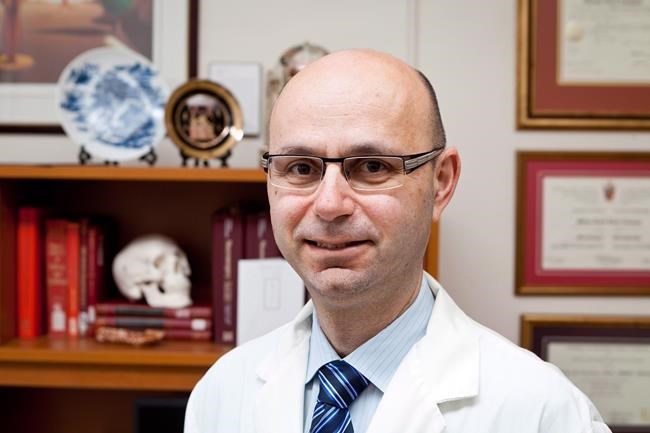TORONTO — An avid soccer fan, Toronto-based neurosurgeon Dr. Michael Cusimano gets concerned every time he sees a player stay on the pitch after showing symptoms of a head injury.
He decided to explore the issue at the game's highest level, leading a research team that systematically examined the 2014 FIFA World Cup in Brazil. The results, published online Tuesday in the Journal of the American Medical Association, indicated international recommendations for assessing whether an athlete had suffered a concussion were not followed at the tournament.
"The concussions primarily occur with player-to-player contact in the vast majority of cases," Cusimano said. "Our point with this is very simple. If somebody sustains something, they should be properly assessed. It should ideally be a doctor that properly assesses them.
"It's a very simple message."
The findings also left Cusimano, who's based at St. Michael's Hospital, concerned about the potential trickle-down effect on fans and young players involved in the sport.
"They set the tone for the culture," he said of FIFA, world soccer's governing body. "Let's face it. When they have viewerships of over a billion people ... it's a global phenomenon."
Cusimano led his team in reviewing videotapes of all 64 games from the quadrennial tournament. Researchers found that concerning head collisions occurred on 72 occasions and affected 81 players.
Fourteen players (17 per cent) showed no sign or one sign of a concussion, 45 players (56 per cent) had two signs and 22 players (27 per cent) exhibited three or more signs, the review found. Among players with three or more signs, 19 (86 per cent) returned to play in the same game after an average assessment of just 84 seconds.
"The players deserve proper assessment," Cusimano said. "As a physician, I care about the health of the player. To make a proper assessment is a cornerstone of managing people."
Consensus statements from the 2012 and 2016 International Conference on Concussion in Sports say a sports-related concussion may have a range of clinical symptoms. They include physical signs and cognitive impairment like headache, feeling like being in a fog, loss of consciousness, an unsteady gait, and slowed reaction times.
Conference guidelines, which were adopted by FIFA, say that players showing any signs of concussion should be immediately withdrawn from play and assessed by sideline health-care officials, the review said.
Researchers found the average assessment at the World Cup lasted 107 seconds and that 45 of the players (56 per cent) were assessed by another player, referee or health-care personnel on the field, while 21 players (26 per cent) received no assessment.
"Most of these assessments — even by the health-care personnel — are extremely short in duration and don't really meet the bar that a proper assessment would meet," Cusimano said.
He added that based on the SCAT3 concussion evaluation system in use in 2014, a minimum of 7-10 minutes would be required to do a proper assessment.
"The longest assessment we saw was 180 seconds," Cusimano said. "So they need to be properly assessed is what we're saying. We're not saying every single event is a concussion.
"We're saying that they should just be properly assessed."
The longtime neurosurgeon also recommended that independent physicians be authorized to make concussion assessments and have the final say on whether an athlete can play. He added that would eliminate the possibility of team employees making decisions, since their jobs may be at risk if they make unpopular calls.
"The (team) physicians are clearly under pressure," Cusimano said. "The players are under pressure. The coaches are under pressure. The clubs are under pressure to win.
"But a physician's primary responsibility should be to the health of the injured person."
Cusimano found that most head trauma incidents were due to elbow, head or shoulder-to-head contact. The 81 head collision events that researchers identified were far more than the 19 reported by team physicians to FIFA, the review said.
Cusimano said team physicians may have reported only the most obvious and severe head injuries while players may have under-reported their symptoms to avoid losing playing time.
"If you had a hairline fracture in your leg and you knew it, are you going to go out and basically break your leg in half?" Cusimano said. "Why would you do it? So why do we do it with the brain?"
One of the cases that left Cusimano particularly startled involved Germany midfielder Christoph Kramer, who stayed in the final game despite suffering a head injury after a collision with Argentina defender Ezequiel Garay.
Kramer later had to be helped off the field. In 2015, he told FIFA.com that he has no memory of the game.
"He got a cursory assessment and then went back onto the field," Cusimano said. "Then a little while later, they took him off. What was wrong with the first assessment? That's amazing.
"He showed three signs of concussion and they let him play for another 13 minutes?"
Cusimano said he approached FIFA at the beginning of his project, was told they were also planning to look at the issue and would welcome feedback, but didn't hear from the organization again.
He then went through the peer review process. A message left with FIFA by The Canadian Press was not returned.
The 2018 World Cup will be held next summer in Russia. Cusimano sees it as another big opportunity to make progress on the issue.
"I think there's enough time to get proper training, to get some independent physicians set up, have the process for that developed in time for the next World Cup," he said.
"I think they could show the world a good example."
———
Follow @GregoryStrongCP on Twitter.
Gregory Strong, The Canadian Press

